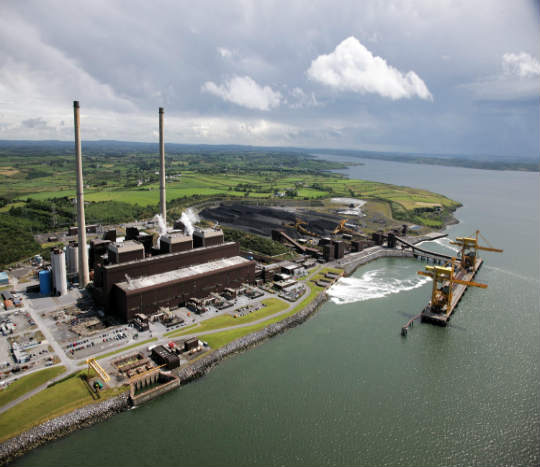Modern energy supply began as a private or local service of gas and electricity, largely based on coal in the early 20th Century. This grew to become national state-owned utilities, which was later unbundled to facilitate competition in generation and customer choice of supplier. The pattern of energy demand has shifted over the years reflecting economic growth throughout history as well as changing relative costs of different fuels, the perceived security of continued supplies and more recently, environmental considerations.
Pre-1800
- 1638 Coal discovered in Leinster coal field. First shallow pit opens in 1638.
- 1684 Rev. John Clayton who later became Dean of Kildare demonstrated production of combustible gas from coal, referred to as the “spirit of the coal”.
- 1765 Coal discovered in Connaught coal field and was initially mined as fuel for iron smelting furnaces. Mining continued until 1990.

1820
- 1822 Four gasworks in Ireland, producing gas mainly from coal. The early uses of coal-gas were largely confined to lighting, which replaced candle and oil power for public lighting.
- 1824 By this time there were three gasworks in Dublin; one operating from coal, one from fish-oil and another from turf.
1830
- 1834 Ireland’s first railway opens, running from Dublin to Kingstown (now Dun Laoghaire). It is the earliest dedicated commuter railway in the world.
1840
- 1845 A public enterprise was set up in Dublin to distribute gas produced from coal.
- 1845 During the famine years the one of the only forms of heat for cooking and warmth was a peat fire. Where local pits existed, coal also protected the population from the worst ravages of the famine providing employment and fuel.

1890
- 1892 Dublin Corporation opened its first electricity Power Station in Fleet Street.
1910
- 1914 World War I (1914-1918). This impacted on Irish industry with restrictions on coal and higher transportation rates.
1920
- 1921 A Commission of Enquiry into the Resources and Industries of Ireland estimated that Ireland used an estimated 4.7 million tonnes of coal and 6 million tonnes of peat.
- 1925 By this time hydro, coal, peat, gas and wind power were all being utilised in one form or another to generate electricity.
- 1927 The ESB (Electricity Supply Board) is established to provide a safe, reliable and economic supply of electricity to the community under the Electricity Supply Bill.
- 1929 The coal-fired station at Pigeon House is acquired by ESB.
1930
- 1939 World War II (1939-1945). Widespread rationing and shortage of fuel for industrial, domestic and transport use. Stoppages of coal for domestic use led to an immediate consumption of gas. Soon even gas was only available at reduced amounts for fixed hours of suply.
1950
- 1950 World prices of oil had fallen after the war to a point where it became competitive with coal for gas manufacture and power generation.
- 1950 High coal prices meant that those gas companies which had survived the hardships of the war moved away from coal carbonisation.
1970
- 1977 Government grant scheme for installation of domestic solid fuel central heating.
- 1979 Construction of a coal-fired power station at Moneypoint Co Clare began and plans for a nuclear power station at Carnsore Point, Co. Wexford are shelved.

1980
- 1987 Ireland’s single remaining coal fired power plant opens at Moneypoint as part of a fuel diversity strategy. At full output the station consumes approximately 7000 tonnes of coal per day.
- 1987 Many districts in urban cities found to be in breach of smoke and SO2 standards in winter, largely due to the open fire combustion of bituminous coal. The Air Pollution Act is transposed banning the sale and supply of smoky coal.
2000
- 2001 Ireland’s fuel import dependency reaches 90%, and continues close to this level until 2014.
2010
- 2012 High gas prices and low coal and ETS prices resulted in more coal and peat being used for electricity generation.